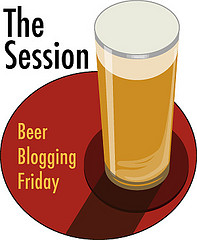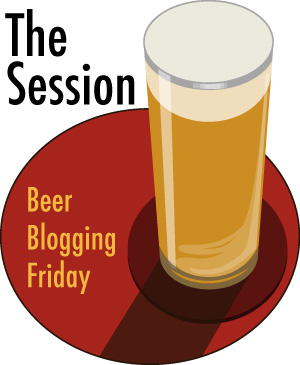 Well this is fun. Writing my own entry for The Session that I’m hosting/foisting on my fellow beer bloggers. The self-imposed assignment is to write about how (I) would design (my) dream beer festival. Conceptually, I tried to take all the major facets into account: theme, beer style(s), location, attendance, ticket pricing, and my overarching-ampersand that affects the way I think about enjoying beer, writing about beer, and celebrating beer, “and,” as in “beer and.” In other words, this is a festival for beer and what-else?
Well this is fun. Writing my own entry for The Session that I’m hosting/foisting on my fellow beer bloggers. The self-imposed assignment is to write about how (I) would design (my) dream beer festival. Conceptually, I tried to take all the major facets into account: theme, beer style(s), location, attendance, ticket pricing, and my overarching-ampersand that affects the way I think about enjoying beer, writing about beer, and celebrating beer, “and,” as in “beer and.” In other words, this is a festival for beer and what-else?
The level of self-interest in this ain’t veiled. I actually throw a few beer festivals back in Portland where I got to live from 2010 to the summer of 2017. And I may take a stab at one here in SoCal (since beerfests and sun go snifter-in-hand). My first baby is Baker’s Dozen in which I invite a baker’s dozen worth of breweries to make a coffee beer using 13 roasters’ beans and attendees also get samples from 13 doughnuteries (the 4th annual fest will be March 11, 2018). There’s Kriekfest, a celebration of Belgian Kriek-inspired beers or imports from Belgium that takes place in the Columbia River Gorge surrounded by Oregon cherry orchards (mark your calendars for July 21, 2018). For a couple years I had a hoot doing The Rural Brewer, inspired both by visiting all the tiny Oregon breweries in tiny towns far from the greater beer map as well as the running gag in 30 Rock about an off-broadway musical, The Rural Juror. And, what started as and really should’ve remained just a fun what-if exercise in beerfest tomfoolery, City of Goses. (Because beer puns.)
What these tell me is that I clearly love niche beer festivals. And that, both by design in the fact that sales are capped and never would’ve sold far beyond that cap (500), I prefer settings that are cozier. It’s what the Dutch call gezellig. That was my pitch to Portland’s moribund Bazi Bierbrasserie in launching Gluhbier Night—an intimate affair of warm, mulled beers that are a way of life at European Christmas markets (along with the infinitely more popular gluhwein). Beer fests, to me, are like the perfect concerts. It’s not that I’ve never attended stadium concerts (Rolling Stones. Eric Clapton. Even Michael Jackson at Dodger Stadium supporting Thriller!). And it’s not that I don’t love OBF and GABF with their thousands and thousands of revelers. But when you’re at a smaller venue, you feel a sense of camaraderie and anyone there might become your new beer drinking buddy. I’m still friends with someone I met a decade ago at a blues and brews fest, highlighting the power of both beer and music. So for me, when the number of attendees stretches out into the triple digits but not the fours, I think you’re really mashing with steam.
Style-wise, there’s absolutely something to be said for a fest where you get to enjoy as wide a range of styles as brewers can conceive. My palate doesn’t mind bouncing around from bitter IPA to boozy BBA behemoth to puckering lambic-style and then mellow out with an approachable Continental lager. But my dream beer fest doesn’t peddle in that kind of cerveza schizophrenia. I do relish IPAs, stouts, and barrel-aged beers, but there’s no shortage of IPA fests (and IIPA and IIIPA) or dark beer fests or wood-aged ones. I’m not interested in recreating an event that’s been done before. Clearly, I really love coffee beers. And my favorite fruited beers really are cherry ones (sorry Framboise-o-philes, I rarely share your raspberry romance). One beer fest I loved conceptually was Mighty Mites, conceived and curated by session beer statesman Jeff Alworth. Nothing over 4% ABV! Imagine a fest where you can truly sample every beer and walk out on your own accord. It occurred once and then Bazi continued a watered down (I see what I did there) version of it as part of the Hawthorn Street Fair. I also was enamored with Portland Mercury’s Malt Ball, wherein Portland brewers and bands truly sat down and created a beer designed to pair with the band’s sound. They never pulled it off perfectly, but the concept was divine. So for this imaginary fest I’m scheming up, one thing I’m currently crushing on is herbal beers. (Sage beers, anyone?!) Saisons infused with Basil or thyme supplement my love of hops. This is very much in the domain of Beers Made By Walking.
 As for my “beer and” thoughts above, since every festival is essentially a giant beer garden, naturally this one would have a giant herb garden. Picture a farmer’s market meets cooking demonstration where you get to learn about ways to use these various herbs: homemade tinctures, remedies, growing tips, and more. Keep in mind I can hardly grow a bed of mint so this is something I could really use.
As for my “beer and” thoughts above, since every festival is essentially a giant beer garden, naturally this one would have a giant herb garden. Picture a farmer’s market meets cooking demonstration where you get to learn about ways to use these various herbs: homemade tinctures, remedies, growing tips, and more. Keep in mind I can hardly grow a bed of mint so this is something I could really use.
As for the twin elements of festival location and region the participating breweries hail from, which I cushioned as “locavore vs. globetrotter,” I’m torn on this. Much like the best beer is, theoretically, the one in my hands, the best beer fest is the one closest to me. But in reality, neither is always or frequently true. I’ve seen some beer events championing smoked beers, and I have no clue if this is a thing, but if someone held a Rauchbierfest in Bamberg, I’d be part of that zeitgeist. Still, I’d like to see the best of smoke from breweries in and beyond Franconia. I’m still kicking myself for not getting to Night of Great Thirst, Belgium’s lambicfest, when we lived in neighboring Holland. And even that now includes great representations from breweries as far afield as the USA. So my mythical Herbal Beer Fest for anywhere from 500-999 beer fans is to be held in a gnome’s garden or a færie’s forest. And I want creatures from all around to fly or burrow their way in.
Incidentally, one of the items I put forward to participants for this exercise is to come up with the price of admission. This is something I completely struggle with IRL. As the events organizer, I confess I’d like to make money off of them. As someone who attends way more beer fests than I put on, I like to not spend a ton. I’m convinced that my events are a great value, based on how little I’ve ever made off of them. Maybe I should bring in sponsors. Maybe I should charge more. One thing I’ll never do is offer a VIP session. Unlike, say, flying somewhere where the passengers have nothing in common except a destination, concert goers and festival attendees are in it together. They should be communal and therefore egalitarian. (By way of confession, when I accept media passes to a beerfest, they sometimes include the perks of VIP admission. Perhaps that’s hypocritical, but I’d never pay extra to feel entitled to MORE of the beerfest than my anyone else. Also, I never use all my media tokens and end up sharing them with strangers.) So I don’t like to give anyone special privileges just because they could pay more than the hoi polloi. Maybe that’s just me and maybe I’m leaving money on the table as a result.
Now, am I really going to put on this beerfest? No. Well, never say never. Like I said, I do want to create something here in SoCal that we don’t already have. And despite the bi-annual release of the Stone Brewing collab saison featuring parsley, sage, rosemary, and thyme, I don’t believe there’s any event just for herbal beers. If anyone reading this wants to partner, you know where to find me. But first, gut check: would you buy a ticket?


 Before I even jump into the 129th entry in the decade-long running Beer Blogging Session, I’m happy to announce that
Before I even jump into the 129th entry in the decade-long running Beer Blogging Session, I’m happy to announce that 

 So the 127th topic for The Session is, if you’ll pardon the crude analogies, akin to asking Cheech & Chong about what makes a great head shop or the late Hugh Hefner which campuses to scour for Playmates. Let’s let Jack Perdue over at Deep Beer set it up:
So the 127th topic for The Session is, if you’ll pardon the crude analogies, akin to asking Cheech & Chong about what makes a great head shop or the late Hugh Hefner which campuses to scour for Playmates. Let’s let Jack Perdue over at Deep Beer set it up:
 The Session creator Stan Hieronymus first launched this beer blogging exercise in 2007. For his third time hosting, he poses the question
The Session creator Stan Hieronymus first launched this beer blogging exercise in 2007. For his third time hosting, he poses the question 
 As a precursor, to put this briefly, I’ve been a bad beer blogger. And when it comes to The Session, if I were Catholic, I’d type something like “Forgive me Father, it’s been 30 Sessions since my last participation.” (
As a precursor, to put this briefly, I’ve been a bad beer blogger. And when it comes to The Session, if I were Catholic, I’d type something like “Forgive me Father, it’s been 30 Sessions since my last participation.” (